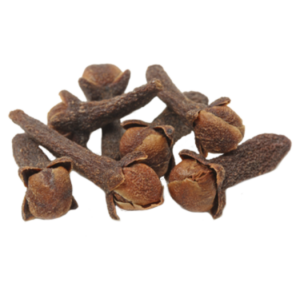CogniSpice
Naturalness
CogniSpice, a formula heart inspired by nature!
Traditional Chinese Medicine
The extract, already used in Traditional Chinese Medicine for 3,000 years, is known for its neuroprotective activity.
The relative quantities of clove and sandalwood have made it possible to maximize the antioxidant power of the best formula, CogniSpice, through experimental design.
CogniSpice is made up of 9 plants and spices, with clove as the main ingredient.
Latest Projects
Clove, an effective neuroprotector
This plant contains the highest quantity of polyphenols and antioxidants.
Its main active ingredient is eugenol.

Eugenol is an aromatic compound renowned for its antiseptic, healing, analgesic and anesthetic benefits.
It has been shown to protect neurons and promote neuronal connectivity (neurogenesis).

Other plants in CogniSpice
- Clove Bud
- Sandalwood
- Oud wood
- Frankincense
- Camphor tree
- Styrax resin
- Cyperus rhizomes
- Saussurea roots
- Liquidambar resin

- Eugenia caryophyllata
Eugenia caryophyllata, a member of the Myrtaceae family, is native to the Moluccas in Indonesia, but is also cultivated on the islands of Penang, Ambon, Pemba, Zanzibar, Sumatra, Madagascar and Mauritius, as well as in the Seychelles and the West Indies. Cloves are the aromatic flower buds of Eugenia caryophyllata.
Properties
The essential oil obtained from the buds of this plant is used as a toothache remedy. The plant also has antioxidant, antiseptic, anti-irritant and carminative properties. In traditional Iranian medicine, the buds of this plant have been used as an anti-epileptic remedy.
Eugenia caryophyllata extract has antibacterial activity against pathogenic bacteria. Its antiviral efficacy is also well documented against herpes and the hepatitis C virus.
Clove essential oil is also used as a local anesthetic and analgesic for sterilization purposes. It is also said to have antifungal, anticonvulsant, anticarcinogenic and antimutagenic activities.
Main constituents
Clove essential oil comprises a total of 23 identified constituents, including eugenol (76.8%), β-caryophyllene (17.4%), α-humulene (2.1%) and eugenyl acetate (1.2%).

- Santalum album
Santalum album, also known as sandalwood, is a medium-sized tree that grows to 8-12 m in height and 2.5 m in circumference. It is mainly grown in southern India, Sri Lanka, Australia and the Malay Archipelago.
Properties
This tree is economically important for its heartwood and essential oil, which is used in perfumery, medicine, cosmetics and the Agarbathi (incense sticks) industry.
The volatile matter obtained by steam distillation of Santalum album heartwood is called sandalwood oil and is used in aromatherapy.
Sandalwood oil has a number of interesting biological activities, including antiviral, antimicrobial, anticancer and antigastric properties. It is also a powerful inhibitor of tyrosinase and cholinesterase.
Main constituents
Sandalwood oil contains a variety of aromatic compounds and sesquiterpenes. Two sesquiterpenols (α- and β-santalol) are the main constituents of this essential oil, of which the alpha isomer, a volatile tricyclic sesquiterpene, is predominant.
The commercial value of the essential oil depends on its santalol content.
Oils derived from wood have higher percentages of santalols, while those produced from branches and leaves contain higher levels of farnesol and bisabolol.

- Aquilaria agallocha
Aquilaria is a species of aromatic plant commonly known as “Gaharu wood” in Southeast Asia.
It is found mainly in Malaysia, Indonesia, India, Iran, Singapore, Bangladesh, Myanmar, the Philippines and Thailand.
Aquilaria Agallocha (Malaccensis) produces a precious resin marinated in heartwood. This resin is derived from the plant’s natural immune response to fungal attack.
Properties
The endophyte is a fungus that lives inside the healthy plant tissues of Aquilaria. Some of these endophytes have been found to have antibacterial properties.
Aquilaria agallocha essential oil is easy to produce and commonly used in traditional medicine to relieve pain, fever, rheumatism and asthma. Aquilaria agallocha oil has strong cytotoxic activity against human colon cancer cells and may therefore be a good candidate for cancer treatment.
Aqueous extract of Aquilaria agallocha stems makes an important contribution to the treatment of anaphylaxis and may be useful for other allergic diseases. The hexane extract of Aquilaria agallocha leaves has strong antioxidant properties.
Main constituents
A number of compounds have been extracted from Aquilaria agallocha, including alkaloids, tannins, saponins, triterpenoids, glycosides and quinones.
Boswellia carteri
Boswellia carteri, commonly known as olibanum, is a small deciduous tree in the Burseraceae family. It is the primary tree of the Boswellia genus from which frankincense, a dried resinous sap known as olibanum, is harvested.
It is native to the Arabian Peninsula (Oman, Yemen) and North-East Africa (Somalia).
Properties
Boswellia carteri resin is one of the oldest fragrant and medicinal resins known worldwide. It has been used in traditional Ayurvedic medicine to treat rheumatoid arthritis and other inflammatory diseases in many countries. It also has activity against tumor cells and chemopreventive effects.
Main constituents
The main active components of Boswellia carteri resin are boswellic acids belonging to the pentacyclic triterpenes of the ursane and oleanane type.

Cinnamomum camphora
Tropical tree, initially upright, spreading with age. Evergreen, leathery leaves. Bunches of small, greenish-yellow flowers, followed by black berries.
Crumpling the leaves gives off a camphor-like scent. It can be planted outdoors in Mediterranean regions.
Planting
Exposure to sun, half-shade, frost hardiness (min. t°: 5°), drained to light soil type, normal soil richness, fresh soil moisture, heather soil ph (acid), neutral.
Characteristics
Plant, unscented, height at maturity 20 m, width at maturity 15 m, insignificant bloom color, blooming months April and May, foliage color green, type of evergreen foliage, spreading habit.

- Styrax benzoin
Styrax benzoin is a species of tree native to Sumatra in Indonesia, belonging to the Styracaceae family.
This tree produces a balsamic resin (benzoin), a pathological product that emerges from the stem when deep cuts are made in the bark.
Properties
Sumatran benzoin is widely used in Asia, not only for wound healing, erythema and coughs, but also for religious rites.
It is often used in soap and detergent fragrances thanks to its fixing properties, as well as in chocolate-type aromas to which it adds interesting warm, spicy notes.
Main constituents
The main constituents of Sumatran benzoin are benzyl benzoate, cinnamic acid, benzyl cinnamate, styrene, benzoic acid, cinnamyl benzoate, allyl benzoate, benzaldehyde and methyl benzoate.

- Cyperus rotundus
Cyperus rotundus (Cyperaceae) is a traditional medicinal plant in China, India and Japan, widespread in tropical and temperate subtropical regions of the world.
It is one of the oldest known and most important edible herbs.
Properties
The tuberous part of Cyperus rotundus is one of the oldest known medicinal plants, used as an analgesic, anti-inflammatory, sedative, antispasmodic and to relieve diarrhoea. It stimulates the thyroid, increases metabolism and acts as a carminative.
Cyperus rotundus tuber extract significantly prevents cognitive deficits, suggesting its therapeutic potential in age-related neurodegenerative disorders. The essential oil of Cyperus rotundus tubers has antibacterial, antimutagenic and antigenotoxic effects.
Main constituents
Cyperus rotundus essential oil is rich in mono and sesquiterpenes.
Its main constituents are α-cyperone and cyperene, the most abundant compounds. Other compounds present in appreciable quantities are cyperotundene, rotundene and cyperol.

- Saussurea lappa
Saussurea lappa is a tall, robust, perennial herbaceous plant of the Asteraceae family.
It grows in Kashmir, the Himalayas, Punjab and the upper Kullu Valley at altitudes of 2,500-3,000 m. The roots are warm, bitter, sweet, pungent and flattering.
Properties
Saussurea lappa is a traditional medicinal plant used to treat asthma, inflammation, rheumatism, coughs, tuberculosis and many other illnesses. It is also used as an analgesic, digestive, aphrodisiac, hepatoprotector and diuretic.
Previous studies have shown that Saussurea lappa root extract has several pharmacological properties, including antioxidant, antiulcer, anticancer and antiviral activity.
Main constituents
Sesquiterpene lactones such as costunolide and dehydrocostus lactone are the most common major constituents of Saussurea lappa.
The plant also contains flavonoids, lignans, phenylpropanoids, alkaloids, triterpenes and phytosterols.

- Liquidambar orientalis
Liquidambar orientalis, a tree of the Hamamelidaceae family, or Altingiaceae according to phylogenetic classification, commonly known as “oriental sweetgum”, is a deciduous tree of the Liquidambar genus, native to the eastern Mediterranean region, occurring mainly in the flood plains of southwest Turkey and on the Greek island of Rhodes.
Properties
Most of sweetgum’s medicinal properties derive from the resinous sap released when the tree’s outer bark is damaged. The sap, known as storax, has been used for centuries to treat common ailments such as skin problems, coughs and ulcers.
More recently, storax has proved to be a strong antimicrobial agent, even against multi-resistant bacteria such as Staphylococcus aureus.
Other extracts derived from Sweetgum show antioxidant, anti-inflammatory, chemopreventive and anticonvulsant effects. Sap extracts have antifungal activity against various phytopathogenic fungi, and have been effective treatments for nematodes and yellow mosquitoes.
Main constituents
Sweetgum trees are important resources for medicinal and other beneficial compounds. The main phenolic compounds in liquidambar orientalis are gallic acid, protocatechic acid, catechin and caffeic, protocatechic acid, catechin, caffeic acid, quercetin and ferulic acid.



